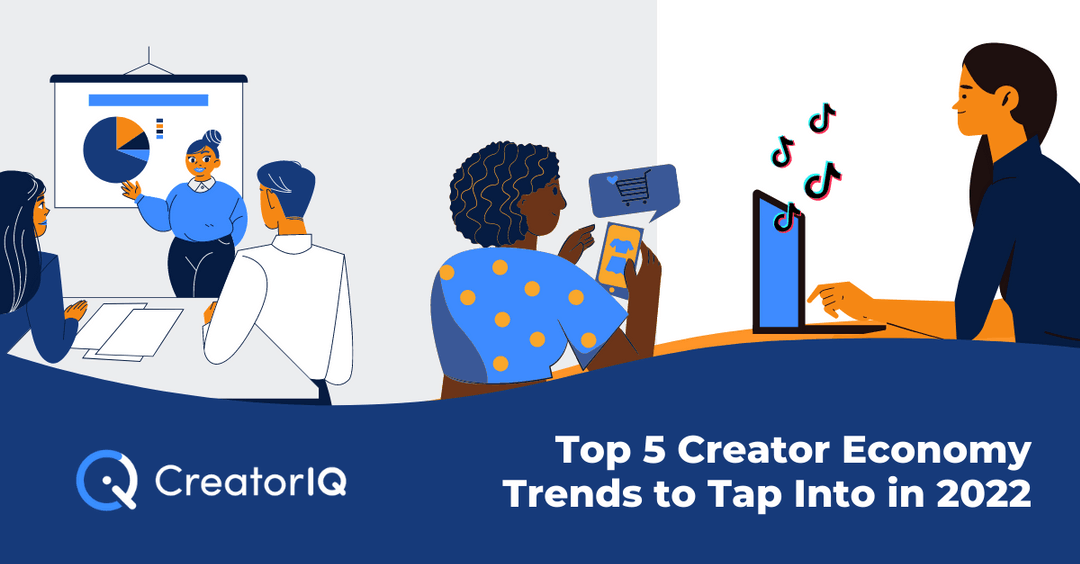Over the past two years, the Creator Economy has blossomed into a full-fledged social media force that has changed marketing and business strategies around the globe. Creators have garnered the power to transform industries, platforms, and even boardroom conversations. Savvy marketers know not to sleep on these developments and have become smart in how they partner with creators for strong, full-funnel influencer marketing strategy in 2022 and beyond. We’ve been observing these developments and came up with the top 5 trends that will impact influencer marketing next year, the apex of the Creator Economy.
1. Full-Funnel Business Outcomes
The maturation of the influencer marketing industry will see brands focus on business outcomes through the entire funnel using creators at every touchpoint. Top of funnel metrics like earned media value, reach, and brand lift will continue their prominent place for some brands, while others will use machine learning to search for ideal creators who can deliver outcomes that are more mid (intent) and bottom (sales) funnel.
Pro Tip: Segment creators based on where they perform most strongly - top of the funnel (high quality content, substantial following with relatively high engagement rate, openness to whitelisting), middle of the funnel (paid media, content optimization), bottom of the funnel (affiliate performance, sales conversions). Measure and benchmark regularly to ensure you are getting the best deliverables out of the optimal creators.
2. Long-Term Creator Relationships
Nurturing long-term relationships with creators will be the key to the success of these programs. The Creator Economy has become very powerful for B2C brands - from large global enterprises to fast-growing DTCs. For brands to succeed in this environment, they will have to approach creators as creative partners, develop trust, and build mutually beneficial partnerships. A great example is the recent deal between Pretty Little Thing and Molly-Mae Hague who will serve as the brand’s creative director, bringing her own - and her 6.1M-strong Instagram audience’s - perspective to the fashion label’s creative content and product offerings.
Pro tip: incorporate your top-performing creators’ perspectives into the wider marketing mix for the greatest impact on conversion. After all, they understand their audience deeply and having their perspective represented in things like pricing and packaging could make all the difference when it comes to transitioning from the Consideration to Purchase phase of the buyer’s journey.
3. Data-Driven Strategy & Advanced Measurement
At the technical level, we expect brands to get smarter about data and measurement. From machine-learning-powered search to building lookalike audiences and brand affinities, a data-driven approach will be vital to measure against other key marketing channels. Reporting and measurement will advance to more precise attribution and insights, particularly down-funnel, which will enable brands to create predictive models to continue scaling their programs efficiently in the future.
4. Social Commerce
As platforms continue to unroll partnerships with e-commerce tools, brands will expand their influencer marketing programs toward social commerce. We also expect a new wave of convergence of affiliate and influencer marketing, more sophisticated and data-driven ambassador programs powering both, and programs becoming truly global in nature like the Amazon Influencer Program. In a world where affiliate marketing is responsible for 16% of global ecommerce sales, such strategies simply cannot be ignored.
5. TikTok
TikTok will continue its stronghold on Gen Z, and brands will continue competing to get noticed on the platform. The key will be to partner with the right creators and let them drive the creative decisions and strategy. As the Creator Economy continues to mature, new tools and agencies will emerge to help creators develop their own DTC brands and launch creator-led products. This is why it’s important for brands to build these long-term partnerships now.
Other social media and content platforms, including Instagram, Facebook, Twitter, and YouTube will continue to try to catch up with TikTok’s astronomical growth.
The Takeaway
2022 will be the year to put your influencer marketing program at the center of your cross-channel strategy. Getting in early with rising creators and fostering strong relationships with your top performers and brand enthusiasts will ensure you get a head start on emerging trends across platforms. Creators will be your best resource, not just for content creation and impressions, but for your entire marketing and business strategy through the entire funnel.
